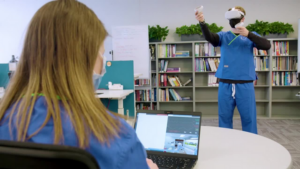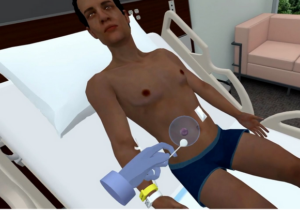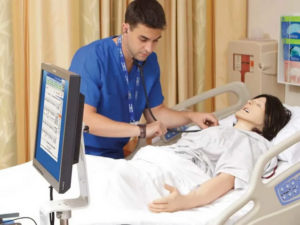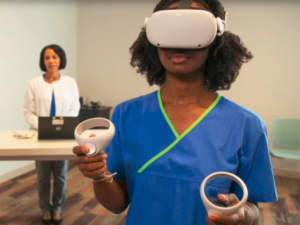Shadow Health Assignments
Simulation Learning System (SLS) as an Alternative Clinical Experience
 As nursing education continues to adapt to new challenges, one of the most significant opportunities is to explore the potential of Simulation Learning Systems (SLS) as a valuable tool.
As nursing education continues to adapt to new challenges, one of the most significant opportunities is to explore the potential of Simulation Learning Systems (SLS) as a valuable tool.
SLS provides an innovative way for nursing students to gain clinical experience without being in a traditional healthcare setting.
These systems allow students to engage with realistic virtual clinical experiences that closely mirror real-life patient care situations.
By using simulation-based learning, students can practice essential clinical skills and decision-making in a safe, controlled environment.
Why SLS is a Valuable Tool for Virtual Clinical Experiences
With the increasing shift toward remote nursing education and online nursing courses, SLS plays a key role in ensuring that nursing students still get the necessary exposure to clinical skills and patient care. The virtual clinical experience for nursing students offers an alternative to traditional in-person clinicals, allowing them to participate in nursing simulation scenarios and practice skills that they would normally develop through hands-on clinical hours. SLS nursing education solutions allow students to engage with technology that simulates real-world patient encounters, making it a reliable alternative for nursing clinical hours alternatives.

Struggling to meet your deadline?
Get your assignment on Simulation Learning System (SLS) as an Alternative Clinical Experience done by certified MDs and PhDs in the USA. ORDER NOW!
How SLS Enhances Nursing Education with EHR and Clinical Resources
One of the standout features of SLS is its integration with EHR in nursing education, which allows students to interact with the same electronic health record systems used in hospitals and clinics. By navigating the SimChart EHR, students can learn how to document patient information, review lab results, and make informed decisions about patient care. Additionally, the inclusion of resources such as Clinical Key and clinical pharmacology in nursing education enriches the simulation experience, giving students access to the latest research and pharmacological data to guide their clinical decision-making. 
Creating Realistic Nursing Scenarios with Simulation Software
Using simulation software for nursing programs, educators can create detailed, realistic nursing scenarios that challenge students to apply their theoretical knowledge in practical situations. These nursing simulation scenarios can involve everything from routine assessments to complex emergency situations. Whether in a physical simulation lab or a virtual environment, students can experience diverse patient situations and refine their clinical skills practice for nursing. The use of simulation-based learning for nursing education not only helps students improve their clinical skills but also strengthens their critical thinking in nursing and clinical decision-making in nursing.
Using Simulation Learning Systems to Replace Clinical Hours
One of the key benefits of SLS is its ability to serve as an effective replacement for traditional clinical hours. With remote nursing education on the rise, it’s important for nursing programs to provide students with opportunities for real-world practice, even in a virtual format. By using nursing simulation technology, educators can recreate patient care scenarios that help students meet the clinical requirements typically fulfilled through in-person clinical rotations. This allows nursing students to progress in their education while gaining valuable experience in a variety of patient care situations, without the need for physical presence in a healthcare setting.
Pre-Simulation Preparation for Nursing Students
Effective pre-clinical preparation in nursing is essential to ensure that students are ready to engage fully in simulation exercises. Before starting a virtual clinical simulation, students should be asked to complete relevant reading materials, SLS pre-sim exercises, and a pre-simulation quiz. This helps them become familiar with the case and the clinical decisions they will need to make during the simulation. It also ensures that they are prepared to apply theoretical knowledge to practice.
Guidelines for Designing Effective Simulation Scenarios
Creating effective simulation scenarios is crucial to achieving the desired educational outcomes. Scenarios should reflect realistic patient encounters, with clear goals that align with nursing competency and course objectives. Each scenario should include tasks like assessing vital signs, prioritizing care, identifying potential complications, and developing a discharge plan. By designing scenarios that challenge students to think critically and make sound clinical decisions, SLS helps build nursing competency and prepares students for real-world nursing practice.
The Role of the Instructor in Virtual Clinical Simulations
Instructors play a key role in the success of virtual clinical simulations. They guide students through the simulation, providing feedback and support as needed. The instructor’s role is not just to observe, but to actively engage with students, helping them understand their clinical decision-making and encouraging reflective thinking. Debriefing in nursing education is an essential component of the learning process, allowing students to discuss their actions, reflect on outcomes, and refine their skills for future patient care. 
Building Critical Nursing Skills Through Simulation-Based Learning
Through simulation exercises in nursing, students can practice and develop a wide range of skills, from clinical assessments to patient care planning. This helps build critical thinking in nursing and strengthens their ability to make complex clinical decisions. Simulation training for nursing students fosters the growth of nursing competency and prepares them to handle various patient scenarios confidently.
Improving Clinical Decision-Making with SLS
One of the core goals of using SLS is to help students improve their clinical decision-making in nursing. By engaging with virtual simulation scenarios, students are encouraged to consider multiple aspects of patient care, such as priority assessments, expected outcomes, and potential complications. As they navigate through each case, students refine their ability to make sound clinical decisions, ensuring better patient outcomes in real-life practice.
Enhancing Critical Thinking Through Simulation
Critical thinking in nursing is essential for making effective decisions in high-pressure situations. SLS helps develop this skill by offering scenarios where students must assess patients, prioritize interventions, and respond to changing conditions. The ability to think critically during these simulations enhances a student’s ability to provide safe, effective care in a real-world clinical setting.
Debriefing After Virtual Simulations: Best Practices for Nursing Educators
After completing simulation exercises in nursing, post-simulation debriefing is crucial for helping students reflect on their performance. It gives them the chance to discuss what went well, what could be improved, and how to approach similar situations in the future. This reflective process helps students solidify their learning and apply it to future patient care scenarios.
Integrating EHR and Clinical Resources in Nursing Simulations
By incorporating EHR in nursing education and other clinical resources like Clinical Key and clinical pharmacology, educators can provide a more immersive and realistic simulation experience. These tools ensure that students not only practice clinical skills but also understand the documentation and research processes that are integral to patient care.
Best Practices for Using SLS Scenarios in Online Nursing Courses
SLS nursing education solutions are ideal for online nursing courses where students may not have access to traditional clinical environments. By integrating simulation-based learning for nursing education into the curriculum, instructors can ensure that students still have the opportunity to practice critical clinical skills and gain valuable experience in patient care.
Addressing Challenges in Remote Nursing Education with SLS
As remote nursing education becomes more common, programs must find ways to offer high-quality clinical training. SLS addresses this challenge by providing a flexible and effective solution for virtual clinical simulations. Through SLS scenarios, students can experience patient care without the limitations of geography or access to physical clinical sites.
How SLS Prepares Nursing Students for Real-World Patient Care
The true value of SLS for nursing students lies in its ability to simulate the complexities of real-world patient care. By engaging with patient care simulations, students can practice assessing patients, identifying complications, and making clinical decisions that affect patient outcomes. This preparation helps ensure that students are ready to provide competent care when they enter the workforce. 
Exploring the Future of Virtual Nursing Clinicals and Simulation Learning
As technology continues to evolve, the future of virtual nursing clinicals looks promising. Advances in nursing simulation technology will likely offer even more realistic and interactive experiences, making it possible for students to practice and perfect their skills in virtual environments before transitioning to the real world.
Using Simulation Scenarios to Teach Nursing Competency
Simulation-based learning plays a key role in teaching nursing competency. By engaging in SLS scenarios, students can develop a wide range of competencies, from basic nursing tasks to advanced clinical decision-making. This ensures that they are prepared for the complexities of real-world healthcare environments.
Ensuring Quality and Consistency in Nursing Education with SLS
By using SLS, nursing programs can ensure consistency and quality in their education. Every student can have access to the same clinical scenarios, receive the same guidance, and have the opportunity to meet the same clinical objectives. This level of consistency ensures that all students receive the training they need to be successful, regardless of location or resources.
The Benefits of Simulation-Based Learning for Nursing Competency and Skill Development
Simulation-based learning for nursing offers numerous benefits, including the ability to improve nursing competency, develop clinical skills, and enhance critical thinking. By integrating SLS into nursing programs, educators can provide students with the tools they need to become competent, confident, and skilled nurses, ready to meet the demands of patient care in the real world.

Dont wait until the last minute.
Provide your requirements and let our native nursing writers deliver your assignments ASAP.